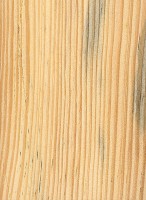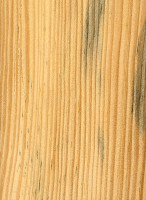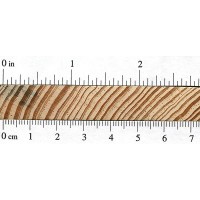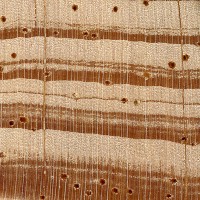 |
Common Name(s): Slash Pine
Scientific Name: Pinus elliottii Distribution: Southeastern United States, though also widely grown on plantations Tree Size: 60-100 ft (18-30 m) tall, 2-3 ft (.6-1 m) trunk diameter Average Dried Weight: 41 lbs/ft3 (655 kg/m3) Specific Gravity (Basic, 12% MC): .54, .66 Janka Hardness: 760 lbf (3,380 N) Modulus of Rupture: 16,300 lbf/in2 (112.4 MPa) Elastic Modulus: 1,980,000 lbf/in2 (13.70 GPa) Crushing Strength: 8,140 lbf/in2 (56.1 MPa) Shrinkage: Radial: 5.4%, Tangential: 7.6%, Volumetric: 12.1%, T/R Ratio: 1.4 |
Color/Appearance: Heartwood is reddish brown, sapwood is yellowish white.
Grain/Texture: Straight grained with a fine to medium texture.
Endgrain: Large resin canals, numerous and evenly distributed, mostly solitary ; earlywood to latewood transition abrupt, color contrast high; tracheid diameter medium-large.
Rot Resistance: The heartwood is rated as moderately resistant to decay.
Workability: Overall, Slash Pine works fairly well with most tools, though the resin can gum up tools and clog sandpaper. Slash Pine glues and finishes well.
Odor: Has a distinct smell that is shared among most species in the Pinus genus.
Allergies/Toxicity: Slash pine has been reported to cause allergic skin reactions and/or asthma in some people. See the articles Wood Allergies and Toxicity and Wood Dust Safety for more information.
Pricing/Availability: Should be widely available as construction lumber for a modest price.
Sustainability: This wood species is not listed in the CITES Appendices, and is reported by the IUCN as being a species of least concern.
Common Uses: Slash Pine is used for heavy construction, such as: bridges, beams, poles, railroad ties, etc. It’s also used for making plywood, wood pulp, and veneers.
Comments: Slash Pine is considered to be in the group of southern yellow pines, and shares many characteristics with other species of this group (Longleaf, Shortleaf, and Loblolly Pine) such as being: hard, dense, and possessing an excellent strength-to-weight ratio.
- Austrian Pine (Pinus nigra)
- Caribbean Pine (Pinus caribaea)
- Eastern White Pine (Pinus strobus)
- Jack Pine (Pinus banksiana)
- Jeffrey Pine (Pinus jeffreyi)
- Khasi Pine (Pinus kesiya)
- Limber Pine (Pinus flexilis)
- Loblolly Pine (Pinus taeda)
- Lodgepole Pine (Pinus contorta)
- Longleaf Pine (Pinus palustris)
- Maritime Pine (Pinus pinaster)
- Ocote Pine (Pinus oocarpa)
- Patula Pine (Pinus patula)
- Pinyon Pine (Pinus edulis)
- Pitch Pine (Pinus rigida)
- Pond Pine (Pinus serotina)
- Ponderosa Pine (Pinus ponderosa)
- Radiata Pine (Pinus radiata)
- Red Pine (Pinus resinosa)
- Sand Pine (Pinus clausa)
- Scots Pine (Pinus sylvestris)
- Shortleaf Pine (Pinus echinata)
- Spruce Pine (Pinus glabra)
- Sugar Pine (Pinus lambertiana)
- Sumatran Pine (Pinus merkusii)
- Table Mountain Pine (Pinus pungens)
- Western White Pine (Pinus monticola)
- Virginia Pine (Pinus virginiana)
 |
 |
 |
 |





65+ year old Slash Pine. Every tree that we have taken down on your land has had these dark red spots as well as some purple. The attached picture is of a tree that was not used for turpentine, but many of our other trees have been and some still have the “cat whiskers” embedded in them. Can you tell me what causes these vibrant colors? Also some of our trees appear to be slowly bleeding. These tree’s trunks are coated in sap towards the bottom and many time when we cut one, the sap inside ends up being green… Read more »